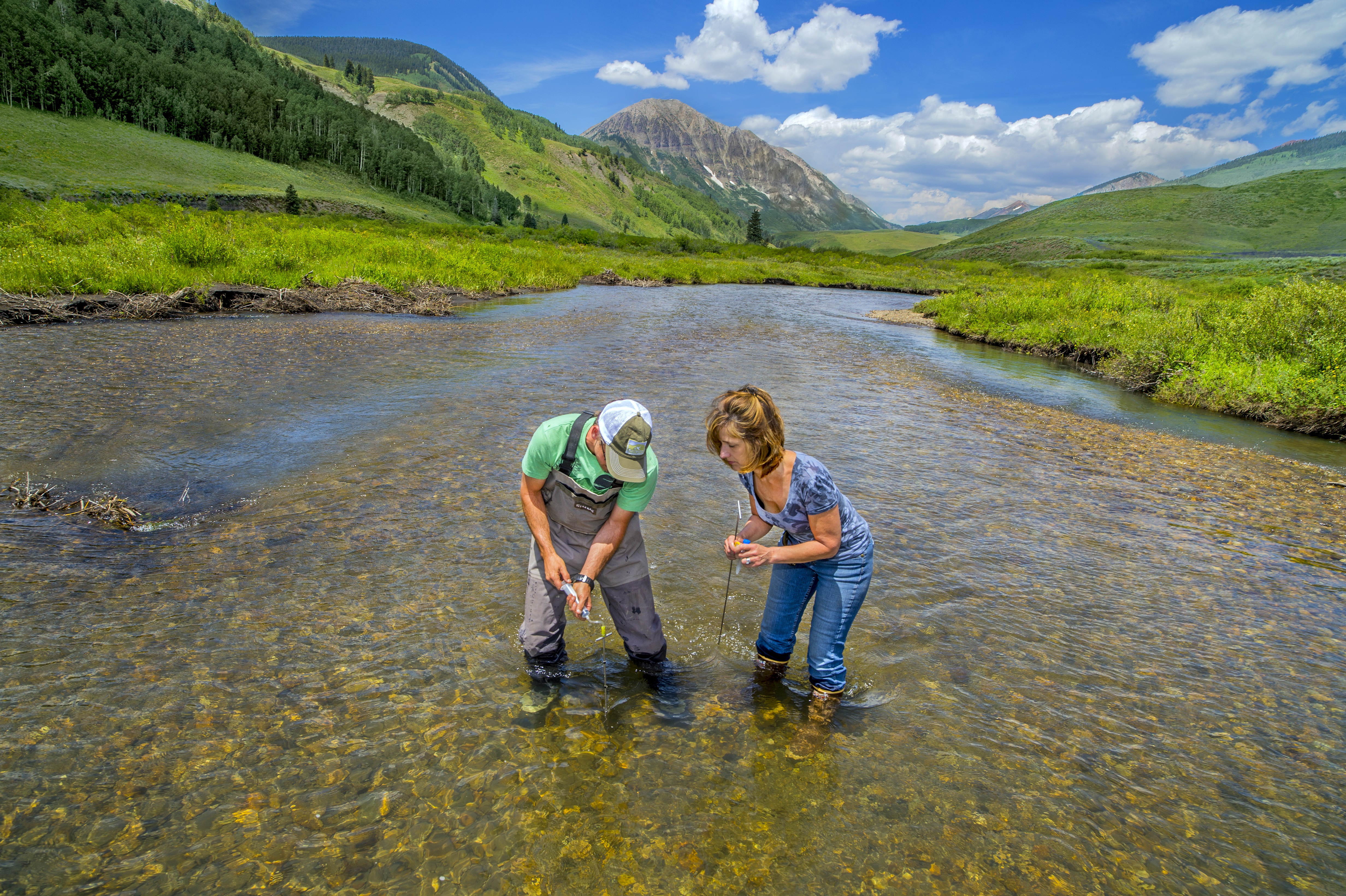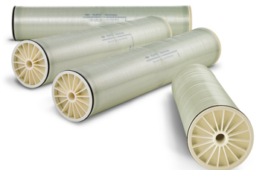Water-Energy Research at Berkeley Lab
Lawrence Berkeley National Laboratory has organized water-energy resilience efforts into four interlocking areas of research activity.
Water Distribution: Researchers are applying long-standing strength in climate modeling to understand where and when water will be distributed in the future. Using the supercomputing capabilities of the National Energy Research Scientific Computing Center, a Department of Energy supercomputer facility at Berkeley Lab, they are able to model and estimate the risks to water supply at a scale of an individual watershed.
Water Generation: Using state-of-theart materials science capabilities at the Molecular Foundry, a DOE nanoscience research facility at Berkeley Lab, and the Joint Center for Artificial Photosynthesis, a DOE Innovation Hub, LBNL is developing new membrane materials for water filtration and reverse osmosis, as well as novel compounds that can selectively remove dilute contaminants in our nation’s water supply, such as lead and arsenic. Using the Advanced Light Source, the brightest soft-x-ray facility in the world, the team is able to probe the atomic-level interactions that control the performance of water treatment compounds and materials.
Water Storage: Groundwater has been traditionally used as a non-renewable resource: “mined” unsustainably causing ground subsidence and decreased water quality. Under LBNL’s Advanced Aquifer Recharge (AAR) program, the lab is developing new geophysical methods to accurately measure where and when water is being returned to the subsurface and geochemical methods to determine how water can be safely withdrawn without mobilizing buried contaminants. •
Water Demand: Understanding, predicting and influencing water demand is a critical part of any sustainable water future. LBNL’s program develops novel methods for gathering data on water use, accurately modeling the economic value of water in different applications and environments, and understanding the relative impact of different water conservation schemes.
A veteran water engineer was recently approached by a reporter and asked to summarize the state of water in the United States. “Where is water going?” the young reporter eagerly asked the veteran expert. The water engineer replied, dryly, “Downhill. Most of the time.”
Metaphorically, and literally, water resources in the United States are in a state of decline. Freshwater supplies are under increasing stress due to the combined forces of climate change and more intensive land use. Droughts are dryer and longer, and storms, when they come, are more violent. In mountainous states like California, less and less precipitation falls in the form of snow (which steadily accumulates and slowly melts), and more falls as rain, which rushes down our rivers and out to sea. All this is made worse by burgeoning urbanization, which is replacing the amount of land that can absorb precipitation with more and more impermeable, man-made infrastructure.
Stress on our water systems puts stress on our energy systems. Why? For starters, water is a critical ingredient in many energy systems. It is required for oil and gas production, for cooling the nation’s power plants, and is used, directly, to generate hydropower. Curtailment of water supplies has led to reduction in power generation at several power plants in several states, and water supply limitations are fundamentally limiting domestic production in a number of oil and gas basins in the U.S.
Water is also a huge consumer of electricity: it’s heavy, and moving it uphill requires enormous expenditures of electricity and massive pumping systems. In California a whopping 19 percent of the total electrical demand is used in some way to move or treat water. Large, centralized water transportation systems like the California Aqueduct consume enormous amounts of electricity lifting water nearly 2,000 feet on its journey to southern California. And the myriad of groundwater wells across the U.S. consume electrical power every time a farmer chooses to pump water from the ground. Water treatment plants in urban environments are typically the largest single energy user in towns and cities.
Distributed energy, distributed water
But hidden within this Gordian tangle of interdependence lies some important opportunities for the United States to use science and technology to stabilize and improve both our water and our energy networks. The technologies our country has developed to create and manage distributed energy generation and distributed energy storage can guide us to develop new technologies to create distributed water generation and distributed water storage.
Lawrence Berkeley National Laboratory, which has a long history of innovation in energy technologies, has plunged into water research in recent years with precisely this framework in mind.
For example, it is becoming increasingly clear that distributed energy generation through rooftop solar will fundamentally alter how we design and operate our electrical grid. Distributed electrical generation allows us to produce significant quantities of electricity, much of which we can use locally to offset demands from the grid. But in order to balance the timing of the supply of renewable energy with the timing of demand, we need to develop more efficient and economical technologies for energy storage. Thus the U.S. Department of Energy has had a longstanding and highly successful effort to improve the capabilities and cost of batteries. The fruits of this investment are now starting to show as recent renewable energy generation projects, combined with battery storage, are being bid at prices comparable to the lowest-cost fossil fuel-powered energy sources.

climatologist Bill Collins and computational researcher Michael Wehner with global climate model. Credit: Lawrence Berkeley National Laboratory
In a similar way, the water “grid” could be made more reliable, more resilient and more energy efficient if we could introduce more distributed water generation and distributed water storage. Distributed water generation involves new technologies to treat and reuse water locally instead of drawing it from miles away through a centralized network. Water is “a pint-a-pound the world around” and is expensive to move, even with the most efficient pumps and pipes. In contrast, local water reuse allows the same pint of water to pass through several unit operations before it has accumulated enough contaminants to require re-treatment. And localized, small-scale treatment systems, designed to extract a specific set of contaminants and produce a finished water composition ideal for a specific use, would save energy by avoiding over-treatment to a quality standard that is not necessary.
Similarly, distributed water “storage” is possible in many parts of the U.S. through a process called aquifer recharge. In this approach, clean water is intentionally diverted to recharge basins, or directly pumped back underground to refill the groundwater aquifer and maintain a balanced supply. Unfortunately, the process of aquifer recharge is still more art than science. Many agricultural districts and urban utilities lack the precision tools to determine how much aquifer recharge is possible, how to locate the optimal places and most efficient methods for recharge, and how to recharge and withdraw water without pulling up contaminants at the same time.
Unfortunately, the U.S. technology portfolio for distributed water generation and distributed water storage is still quite limited. Most of the water treatment technologies available today were developed for large, centralized water treatment systems. They treat huge volumes of water in a slow, steady process to uniform quality standards. In contrast, tomorrow’s water treatment technologies will need to be adaptable to changes in water flow and water composition, and adjustable to produce processed water of different chemistries for different needs.

Berkeley Lab scientist Susan Hubbard (right) at a watershed project site in Rifle, CO, where there is a study underway of contaminants in groundwater. Credit: Lawrence Berkeley National Laboratory
And, in order to reliably utilize groundwater as a “rechargeable resource” we will need to develop new technologies to accurately determine where water can most easily percolate back down into the ground, accurately measure how much water was returned, and how it can be withdrawn without mobilizing contaminants. In many respects, our groundwater basins will need to operate like “water batteries” reliably and repeatedly receiving water for storage when it’s available, and returning that water for use when it’s needed.
The future of the energy grid and the water grid could be truly promising if we can innovate to allow these two systems to work together in collaboration. Water generation and water storage can ramp up when energy supplies are abundant, and slow down when energy demands increase. And distributed renewable energy can directly power distributed water treatment, or feed its energy directly onto the grid. These two systems, working in harmony, could give our agricultural, industrial and municipal sectors an increased level of stability and adaptability in a world where climate extremes will become the new normal.
Peter Fiske is Director of the Water-Energy Resilience Research Institute at Lawrence Berkeley National Laboratory. He was Chief Executive Officer of PAX Water Technologies, Inc., which developed ways to use biomimicry and advanced process control hardware and software to create energy efficient technologies for municipal water systems. Fiske received his Ph.D. from Stanford University in Geological and Environmental Sciences with a concentration in Materials Science and Engineering.




